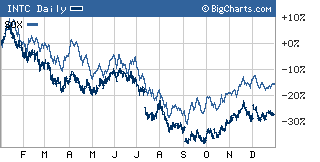NEW YORK (CNN/Money) -
As if Intel wasn't facing enough pressure.
The world's largest maker of semiconductors not only needs to demonstrate to Wall Street that it can get it back on track after a rough 2004, but also finds itself in the position of lead-off hitter for the tech earnings season.
When the world's largest maker of semiconductors gave a rosy fourth quarter sales outlook in early December, it was a homerun. Shares of Intel (Research) shot up more than 5 percent the day of the announcement.
But the enthusiasm was short-lived. Intel has given up those early December gains and the Nasdaq is down about 3 percent since then as well.
So when Intel reports its fourth-quarter results after the closing bell Tuesday, Wall Street will be hoping to hear some bullish comments about tech spending in the first quarter and beyond.
Strong fourth quarter results won't be enough. By all accounts, sales of computers and other electronic gadgets that use semiconductors were solid during the holidays. Analysts expect Intel to report sales of $9.41 billion for the fourth quarter, up 8 percent from a year ago and 11 percent from the third quarter.
But as is usually the case, Wall Street will be more focused on guidance. And Intel's forecast could have an impact on a wide swath of tech companies, ranging from competitors Advanced Micro Devices (Research) and Texas Instruments (Research) and chip equipment suppliers Applied Materials (Research) and Novellus Systems (Research) to PC vendors Dell (Research) and Hewlett-Packard (Research) and software giant Microsoft (Research).
Already, AMD is feeling some pressure, having warned late Monday that revenue for the quarter just ended won't meet up to prior expectations because of competitive pressure.
All eyes on sales guidance and inventories
Analysts are predicting first quarter sales of $8.94 billion. That would be about a 5 percent decline from the fourth quarter. First quarter sales for Intel are typically down sequentially as demand cools after the holidays.
During the past five years, sales have dipped between 2 and 7 percent sequentially with the notable exception of the first quarter of 2001, when sales plunged 23 percent from the fourth quarter of 2000.
 |
|
| Last year was a rough one for most semiconductor stocks, but Intel fared even worse than the Philadelphia Semiconductor Index in 2004. |
So if Intel reaffirms that its sales should fall no more than 5 percent, that would probably be viewed as a good sign.
"Revenues are likely to be down but that's just normal seasonality," said Cody Acree, an analyst with Legg Mason.
Wall Street will also be keeping a close eye on Intel's inventory. Concerns about an inventory glut were a big reason why Intel's stock fell 27 percent last year.
Rising inventory levels last year in the face of slightly weaker demand put a dent in Intel's profitability. Intel's gross margins, which measure how profitable a company is after subtracting the costs of sales, steadily declined in 2004.
As such, fourth quarter earnings are expected to drop slightly on a year-over-year basis, to 31 cents a share from 33 cents in the fourth quarter of 2003.
But the company said in early December that it expected its inventory level to be "several hundred million dollars" lower by the end of the fourth quarter. Intel's inventories were $3.18 billion as of the end of September so Wall Street will want to see this figure below $3 billion as proof that Intel is living up to its promises.
And Acree said if Intel is successful in paring down its inventory, then the company should be able to give conservative gross margin guidance of about 56 to 57 percent for the first quarter, which would be roughly flat with the fourth quarter. That would be encouraging because it could signal that the worst is over for Intel in terms of margin erosion.
Another number to keep an eye out for that will have an impact on Intel's profits is its capital spending forecast for 2005.
In a recent report, Bernstein analyst Adam Parker wrote that if Intel's capital spending plans are for less than $3.8 billion, that would be a good sign for Intel's profits since it would represent little change from the company's estimated 2004 capital expenditures of between $3.6 billion and $4.0 billion. (This news, of course, would not be perceived as a good sign for chip equipment companies though.)
Intel will need to show that it can get its earnings growth back on track again in order to impress Wall Street. Profits for 2005 are currently expected to increase by just 4 percent from 2004. So even though Intel trades at only 19 times 2005 earnings estimates, there is debate about whether or not the stock is a bargain or not.
In addition to the inventory woes, Intel also had some high-profile production problems with some new chips last year and also faced increased competitive pressure from AMD.
Analysts quoted in this story do not own shares of Intel and their firms have no investment banking ties with Intel.

|

